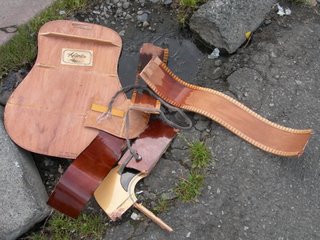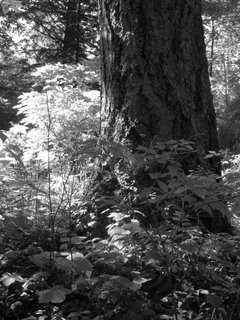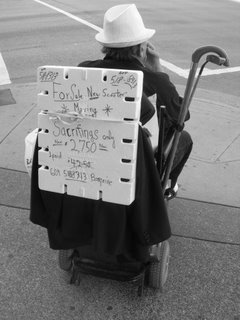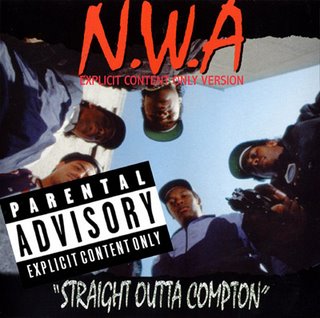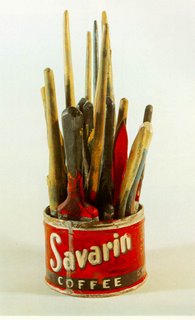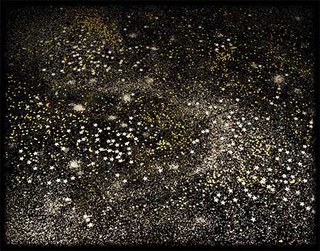Anodyne
Monday, July 31, 2006

We Also Had The Original "Scroll" Typescript For $500
"Eager to write freely and continuously, without pausing to pull finished pages from his typewriter and insert new ones, Kerouac typed instead on 12-foot rolls of paper that he later Scotch-taped together, Sampas said.Living in New York in 1951 and writing about his recent cross-country adventures, Kerouac worked from his own notes, journals, and letters, and frequently added notes and corrections over the typewritten text.
He had previously worked on the book in scattered bursts, but finally laid it all out on paper in a single three-week sprint, Holladay said.
Some specialists say they prefer the unedited version, which features a different first sentence than the published novel, as well as a more abrupt ending.
A cocker spaniel owned by one of Kerouac's friends apparently ate the last section, according to Jim Canary, the head of special collections conservation at Indiana University's Lilly Library."
(Link courtesy jnadiger, who still posts occasionally to his own blog, all evidence to the contrary)
I was fortunate enough to actually lay eyes on the scroll, partially unrolled, in a bulletproof Lucite box at the New York Public Library some time in the early 1990s. Back in Vancouver, I tried to emulate Jack's compositional productivity by downing some borrowed speed, sparking up, and booting up MS Word 6. I got about three sentences completed, then had to break off, because the keys were dancing in front of my eyes. Soon the whole apartment was roiling and shifting around me. I couldn't type, couldn't think, and certainly couldn't sit still. So, at 12:45am, I went to call on my neighbor Mike P., who worked with me at Book and Comic Emporium.
"What the hell do you want?" demanded sleepy Mike, peering out of his third floor attic window.
"I'm fucked up," came the Thompsonesque reply. "Help!"
"Go walk it off," suggested Mike. Bang! went the window.
I walked to UBC and back (5 miles each way). Twice. Home at dawn!
Like the Freak Brothers say, peed skills.
POMPOUS YOUNG HIPSTER WITH EXPENSIVE SHOES: Where's your signed Kerouacs?
CJB: You're kidding, right?
PYHWES: [theatrical sigh] I guess you don't have any, hey?
CJB: What specifically are you looking for?
PYHWES: On The Road. In hardcover.
CJB: [heavy irony] Too bad you didn't come in on Friday. I had a nice association copy, signed to Neal Cassady.
PYHWES: I would have paid a hundred bucks for that book!
Saturday, July 29, 2006

The Steely Dan Show
28 July 2006
White River Ampitheatre, Auburn, WA
Turtle Talk (Dee Baron)
Bodhisattva
Time Out of Mind
Aja
I Got The News
Hey Nineteen
Josie
Green Earrings
Deacon Blues
Black Friday
Dirty Work
Band Intro: Cold Sweat (James Brown) / Show Biz Kids
Do It Again
Peg
Don't Take Me Alive
Kid Charlemagne
Encore
My Old School
Last Tango in Paris (Gato Barbieri)
Setlist now definitively amended. I am downloading the concert as I type, a nice momento soon to be burned to CD and relentlessly inflicted on my staff for months to come.
There is a sweet version of Dee Baron's instrumental Turtle Talk on Stan Kenton's Adventures in Jazz. Donald dressed like Keanu in The Matrix -- huge full-length black leather trenchcoat and wraparound shades. Walter dressed like my high school shop teacher -- sports shirt and slacks. Killer band, especially guitarist Jon Herrington and drummer Keith Carlock. Donald's voice was not the wreck it was when I saw the much larger Steely Dan Orchestra in Toronto in 2003; he sounded pretty much like his studio self and restlessly paced the stage like a cornered rat, tossing off melodica and Keytar [actually a MIDI sequencer with a shoulder strap, says an Internet correspondent] solos. A great show; lots of improvisation and a nice mix of popular favorites and obscurities. The Barbieri instrumental was a "closing number" played by the band long after Walt and Don quit the stage.
(Photo courtesy Seattle's own Steely Diane, several rows ahead of me)
Thursday, July 27, 2006
I'm a Mushroom Cloud-Laying Mother Fucker, Mother Fucker
Found in the tubes of the internets. Courtesy my pal jnadiger. That fat ol' lazy ol' cat just can not catch a break.
Potential Conclusions
1. As magazine criticism becomes steadily more impoverished (for example, Christopher Mooney's breathy, jaw-droppingly inane "profile" of Vancouver's visual arts scene, just published in Modern Painters), sophisticated criticism may withdraw into art, like a hermit crab scrambling into a vacant shell.
2. Criticism may come to employ rhetorical or critical strategies now primarily associated with art; criticism may become "performative." It is easy, for example, to imagine works of criticism taking forms similar to Robert Morris' performance 2.13, or to Andrea Fraser's institutional critiques.
3. A work of criticism-as-art can probably only legitimately be accepted as art if it somehow interrogates its own status as art.
3a. A work of criticism-as-art should somehow aestheticize its critique; in doing so, it will open itself up to critical possibilities its maker(s) might never have previously considered.
4. All these propositions and conclusions may be wrong.
Propositions
1. Artworks can validly illustrate, comment upon, dramatize or stage their own coming-into-being as content. Example: Dan Graham's Schema (1966).
2. This self-reflexivity is not "postmodern," (stylistic quotation; pastiche) but "modern."
3. Criticism impacts artworks' coming-into-being.
3a. Hypothetical example: an artist makes projections and still photographs. Critics argue that the artist's skills stress duration (cutting; montage; rhythm; narrative) over static composition. Moved by this criticism, the artist reflects upon her practice. She accepts the criticism's premises, and ceases to make still pictures.
4. Criticism can equally validly be incorporated into artworks. Example: our hypothetical artist makes a projection about a film director who makes narrative films and still photographs. Think Wim Wenders, or Larry Clark, or Tacita Dean. Characters in the projection critique the director's still images; their criticisms are surrogates for those the artist experienced. These criticisms now enter the artist's work as content. But, significantly, the artist withholds her own judgement of the criticisms, presenting them as objectively as she possibly can. Result: an autonomous art work that critiques and analyzes aspects of its creator's own art production.
A Dan Graham essay on his magazine work, and a Jeff Wall note on the distinction between pictures which are either on or off (lightboxes; projections) or always on (gelatin silver prints; drawings; paintings) gets me thinking about how this particular historical moment (digital cameras; lightjet printers; the Web) differs from past historical moments. Graham observed that, in the late 1960s, an artwork was only accepted as an artwork if it was written about and reproduced in an art magazine. This led him to logically conclude that physical art objects had become an intermediate step in the legitimation-as-art process. Graham experimented by making printed texts and photocollages which were themselves art objects, thereby "dematerializing" the physical art object.
Web publication seems to me to differ from art magazine publication. In the 1960s, publications like Artforum and Artsmagazine shaped and directed taste. These magazines derived their authority from the quality of their contributors' judgements and their crititical up-to-dateness. A young artist living, in, say, Vancouver or some similar cultural backwater in 1968 or 1969 could learn a great deal from an Artforum subscription, including that art was not only made in cultural capitals like New York, Paris, or London, but could realistically and validly be made anywhere....even, say, in Vancouver!
Contrast this with the current state of affairs, in which glossy publications like Art News and Canadian Art act as interpreters of art for readers who hypothetically require the magazines' intercession in order to understand and appreciate art. In the late 1960s, the audience for magazines like Artforum was mainly composed of other artists. The contemporary audience for magazines like Art News is far more nebulous to me. Who are these magazines aimed at? Probably collectors, lazy folks who need constant reassurance about their purchases. No artist in my circle takes Art News' or Canadian Art's pronouncements seriously. How could they, given the hostility these publications routinely display toward intellectual complexity and the neccessity of judgement-making?
Contemporary art magazines no longer fufill the gatekeeper role they once filled in the late 1960s and early 1970s. The Web, by contrast, is an open door into a building containing an infinite number of rooms. Most of what is in those rooms is, by definition, of pretty low quality, but that's not always neccessarily so. The quality of each room's content will depend on each proprietor's skill and judgement, the seriousness they bring to the conceptualization, execution, and presentation of their work. It seems, too, that there is no prohibition against simultaneously creating work and critiquing, contextualizing, or analyzing it. So that the work and its exegesis and/or commentary are no longer separate ("art object" in the gallery; reproduction and "criticism" of the work in the art magazine or printed catalogue) but side-by-side, a process that reveals previously unconsidered aspects of each element's other.
Wednesday, July 26, 2006

You call me a fool
You say it's a crazy scheme
This one's for real
I already bought the dream
So useless to ask me why
Throw a kiss and say goodbye
I'll make it this time
I'm ready to cross that fine line.
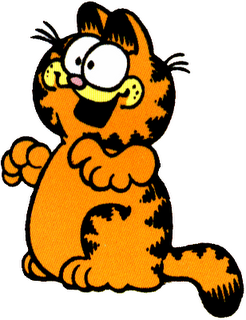
Future Garfield Strips, if Garfield Aged at the Normal Feline Rate
"Jon takes Garfield to the vet, who prescribes medication for Garfield's thyroid problem, which Jon has to administer in the next frame. He inserts a pill into the special device designed to go down Garfield's throat and tries to cram it into Garfield's mouth. Garfield responds by viciously clawing Jon on the arms, legs, and face. 'Stick that there again and I'll stick you!' the thought bubble above Garfield's head says. Jon slouches. 'That's what Claire said, too,' he responds."
Tuesday, July 25, 2006
Legacy Supplement
• Oil change, 4.5 litres WD30 (Premium Brand)
• New Oil Filter
• Transmission Fluid Change
• New Air Filter
• 30 litres Fuel (87 octane)
• Basic Wash
Thus refreshed, the ailing Legacy heads out for reshoots, the first set of "proof prints" having come back from the Lab and been found wanting. But circumstances keep interfering. The VPD is making a solicitation arrest at Hastings & Glen, and parking the Legacy adjacent to the cruiser, the cuffed, cracked-out hooker, and the cuffed, disreputable-looking john doesn't seem like a plausible plan. OK, option #2: back into rush-hour Vancouver. No Stopping Anytime at Pender and Burrard, plus a nasty lip on the curb that looks like it would strip the muffler if I tried to climb it. Fine then, option #3: Stanley Park. A cyclist has come down one of the park's dirt trails too fast and collided with a silver SUV on Park Drive. Ambulance, fire trucks, etc., lights flashing. The unconscious bloody cyclist is strapped to a traction board, and lifted into the back of the ambulance, which splits at high speed, siren wailing. The long line of stalled traffic slowly begins to move again.
Someone who doesn't live in Vancouver writes to ask, "What's up with this hiking thing, anyway?"
It's in my blood, I guess. Growing up in West Vancouver in the early 1970s, across the street from our house was a huge overgrown municipal park with a large creek running through it. On the other side of the road was forest, all the way up to the Upper Levels Highway, which was itself fairly new, having only been completed in the late 1960s. Much of this land is now expensive subdivisions, with multimillion dollar ocean and island views, and not many original trees. I remember going for walks with my mom in 1974 or 1975 up what would later become Westport Road, to gaze into this huge undifferentiated green tangle. Not a dangerous, Snow White-style forest, but something other, brooding, serene, and largely indifferent to people.
My dad hiked a fair bit as a younger man, and took me out as soon as I was old enough to carry a pack. We went to Cheakamus Lake, near Whistler, in 1975. The virtually flat trail to the lake runs through an open old growth forest, and I remember the trip with surprising clarity: the trees' size; garlands and cushions of bright green moss; the glacial blue of the lake. When dru and I were older, the three of us climbed the Squamish Chief one crisp fall Sunday, and the Black Tusk, and Alpha Mountain's shoulder -- this last trip neccessitating renting a canoe, and paddling across the swift Squamish River, and staggering up a 20%+ grade trail with heavy overnight packs for six hours to Lake Lovelywater, a campsite, and a brief respite before the real climbing, which began the following day.
I took friends out, too, in my old battered Honda Civic, and, later, my Tercel, friends who, for the most part, went "hiking" (or scrambling, or full-on mountaineering, ropeless, bushwhacking down wet cliffs covered in blueberry bushes and slippery moss) once, and then found all kinds of excuses to never go again.
Peaks were climbed, nonetheless, including some fairly obscure and remote ones. Most importantly, I never felt lost outside, or helpless, even in the weirdest and most trying circumstances. The lack of a trail was never an impediment to getting where I wanted to go. Pushing through bushes, scrambling up gullies, etc. always seemed a neccessary and enjoyable part of getting up into the alpine.
I've suffered from persistant depression for almost twenty years. Being outside, surrounded by landscape, lifts that depression, draws me out of myself. It's hard to be depressed when you're soaking wet, or sweaty, exhausted and bug-bitten, or quickly retreating from a surprised and unhappy bear.
So, there's some historical context for all the breezy trip reports and stuffed-cat-on-the-summit snapshots. I guess the black and white forest photographs that pop up here and there have something to do with that history, too; they seem framed lower down than my other pictures, as if taken by my five year-old self at the top of Westport Road in 1975, looking out on a landscape that is all one piece, a presence that is not aesthetically pleasing in any conventional Group-of-Seven-meets-Emily-Carr kind of way, but meaningful nonetheless.
Monday, July 24, 2006

Clubtread.com team member Alex Best performs experimental healing techniques on cjb's aching legs. Deeply relaxed, cjb begins to snore. Wildlife flees! Photo courtesy [fellow team member] PiB.
Sunday, July 23, 2006
More recent reading (not much more than titles tonight; the office is at least 35 degrees and sweat is rolling down my face):
J.M. Coetzee, Elizabeth Costello
Michael Connelly, The Lincoln Lawyer

Coming 2 November 2006, a book I'm awaiting more eagerly than Pynchon's just-announced Against The Day. More details here. Despite the cheesy pink neon and the Clive Barker cutline, MJH remains one of the best English language prose stylists I know.
“Howe Sound Two-Fer” (Double ascent of Mount Brunswick, Mount Harvey)
Trip report posted to clubtread.com
20 July 2006
Participants: [clubtread members] Alex Best, cjb, PiB, Q, [honorary mascot] Rose T. Cat
Bored with repetitively climbing Grouse Mountain from sea level, I posted an ascent of Mount Harvey from sea level, and quickly assembled a team of fit overachievers who proposed to scrub the boring “paved suburban hill” portion of the trip, substituting an ambitious plot to knock off two major Howe Sound summits within a few hours of one other. Plus, [clubtread members] mazegirl and her pals had just completed a variation of this route, and the JPEGs and GPS track in their trip report looked really tasty. So the two-summit plan was a go.
Obstacle one was negotiating the West End’s maze of parking restrictions and one-way streets to collect PiB. Obstacle two was a lack of transmission fluid in cjb’s rickety Subaru Legacy, and the funny burning smell eddying out from under the hood. Then there was the equally funny smell eddying out from Alex’s pockets….We negotiated the Cap Road interchange with the Upper Levels, and trundled off to the Lions Trail parking lot in upper Lions Bay.Twenty minutes of hiking up the steep approach road got us to a fork in the trail, where we promptly took a wrong turn and headed up above Magnesia Creek to a huge locked gate. Bzzt! Back down the hill and up the right road, signed, we now notice, with a huge (4’ long) arrow made of rocks.
More switchbacks on the logging road. It’s hot in the trees. We take another fork, cross Magnesia Creek, and begin to switchback steadily up the slopes of Brunswick Mountain through an old clearcut choked with alder. At a viewpoint above the clearcut we stop to introduce ourselves to the local bugs. Suntan lotion is applied. Pic’n’mix is consumed. Alex pulls cloves of raw garlic from his pockets and rubs them all over his exposed skin, as a “scientific experiment” in bug avoidance.
The well-marked trail now streaks directly up the side of Mount Brunswick through a fragrant old-growth forest. It’s hard to appreciate the forest’s beauty with sweat rolling steadily down into your eyes and a cloud of bugs around your head. We estimate the grade at “25% and a bit,” eg., vertical tree climbing. Soon the angle eases into a gorgeous old growth forest dappled with sunlight. Silvery trunks and cool green moss. Alex camcords the proceedings for posterity. As if on cue, the bugs present themselves for posterity, too.
We quickly reach a junction with the Howe Sound Crest Trail. Left for Hat Mountain, right for Magnesia Meadows. Straight up for Mount Brunswick. We suck up the grade and climb steeply out of the trees, up an endless scree ridge, and emerge on a saddle between the west peak and east ridge. Up the east ridge around snow remnants, rock fingers, pale blue mountain lupins and bugs. We scramble the narrow but solid ridge around the remains of a helipad, second-class a rocky step, and pop up onto the summit. Lunchtime! Picture time! Frustration with the new Government of Canada maps, which turn out to be poor quality print-on-demand specials, speckled with digital noise, whose contour lines run together in a big brown stew.
Honorary mascot Rose T. Cat is deployed for summit shots. More garlic, more pic’n’mix, more fruit gums. We debate a “direct” route down to Magnesia Meadows. Common sense overrules the more adventurous among us and we head down the same way we came, till we arrive back at the Howe Sound Crest Trail junction, and turn south, steadily contouring into Magnesia Meadows. This stretch of trail is virtually flat and magnificently scenic, traversing stretches of old growth forest and avalanche swathes, with views opening out to Howe Sound and Mount Harvey’s impressive north face. An hour or so later, which includes crossing some easy snowslopes, we reach the Magnesia Meadows shelter (a rickety red A-frame, open on both sides) and break for lunch at a little lake just south of the shelter. cjb rescues a drowning bee from the lake. PiB strikes Aphrodite poses on a rock out in the water. Alex decides to take a “refreshing dip,” but quickly hops out, confronted by glacial realities. And Q is endlessly amused by her charges.
Refreshed, we make out way to the base of Mount Harvey’s narrow NE ridge and 2nd and 3rd class it up to the summit. Lots of pulling on roots and scrubby trees for balance! The bugs, sensing our attention is properly focused elsewhere, zoom in for the kill. This fairly well-marked route, while not requiring a rope or technical rock climbing skills, is very steep; I would not want to descend it with a pack or in anything other than full daylight. It’s very similar to the descent off the North Needle: an “easy” ridge bracketed on either side by deeply sketchy terrain (bluffs, bushes concealing major drops, loose rock & etc.)
An hour or so on Mount Harvey’s summit, including more hero shots and a conversation with two guys who come charging up the NE ridge behind us, and then down the southern ridgeline through the forest of silvery deadfall just below the summit, followed by the extremely steep and painful descent to the logging road in Lions Bay. cjb’s bad left knee and battered toes have their own opinion of this descent, which leaves him 10-15 minutes behind everyone else. Slow but steady….
Down the logging road at twilight, back to the car at 9 sharp, for a 12-hour, two-summit day, total elevation gain of 1765m. Off to the Troller Pub in Horseshoe Bay for cold ones. A terrific group of people, great terrain, and super weather! No downside to this trip at all. Thanks, everyone!
Saturday, July 22, 2006
Je t'aime, Vancouver (3.0)
29 degrees overnight.
CJB & THE INCREDIBLE TALKING CATS: Zzzzzzz...
SFX: SMASH! (Car being broken into)
SFX: [sirens]
CJB & TITCs: Zzzzzzz...
SFX: CRASH! (Bottles thrown off tenth-floor balcony onto the street)
SFX: [sirens]
CJB & TITCs: Zzzzzzz...
PHONE: Ring! (Long distance call from Scotland)
CJB & TITCs: Zzzzzzz...
SFX: KABAM! Tinkle tinkle CRASH. (Irate party-goer heaving concrete ashtray through the building's front door)
SFX: [sirens]
ALARM CLOCK: Ring!
Hey Luke Wilson! (thx Pete)
"No phone call, no muffin basket, no flowers, nothing."
Speaking of which...28 July 2006, White River Ampitheatre, Auburn, WA, row 6, dead center!

Rose T. Cat on the summit, Mount Harvey, 20 June 2006, the Lions visible in the middle distance, the city's haze behind them.
Wednesday, July 19, 2006
Je t'aime, Vancouver (2.0)
A free evening! I opted to spend it doing several loads of laundry and cleaning the apartment.
Some time between putting my last load in the dryer and coming back downstairs to claim it, some mangy crackhead
a/ Snuck into the basement (swipe card guarded door),
b/ Tore the basement security camera off the ceiling,
c/ Tore the laundry room security camera off the ceiling,
d/ Stole all my laundry (numerous Abercrombie & Fitch Big Shirts ($4 each at the Seattle Goodwill, not exactly ebay-able), socks, etc.), and,
e/ Stole the 12 pairs of boxer shorts drying in the dryer next to mine.
So, if you visit or call today, that's the kind of day I'm having.
Tuesday, July 18, 2006
Je t'aime, Vancouver
Up at 5:30am, I park out on the balcony with a cup of tea and J.M. Coetzee's Elizabeth Costello. Light slowly leaks up into the sky. A cool wind rustles the trees. The neighborhood pigeons dip and flow. An adolescent crow calls, monotonously, off-key, for breakfast.
A guy with Car Thief written all over him (unshaven, ball cap, track pants, swag bag) sneaky-petes it down the sidewalk. He stops in front of the nice red late-model Honda parked directly across the street. Looks left, looks right. Scoots around to the passenger side, pops something heavy from his bag, and smashes the passenger window.
The Honda's car alarm goes off, hoot hoot hoot. I rise to my feet, heading for the phone and 911...
...and the curtains of the second-floor unit across the street whip back. An extremely fit-looking man in his mid-40s, clad only in boxers, vaults over his open windowsill, takes the fourteen foot drop to the lawn, sprints toward his car, and proceeds to beat Mr. Car Thief senseless.
Roll credits, fade to black.

ACT (Aesthetically Claimed Thing): Re-entry (via the NYT)
"Colonel Lindsey said he and the pilot, Commander Kelly, had had a view on the way home that was even more spectacular than usual.
'It started out in darkness, and of course you see the orange glow as the plasma starts heating up,' he said, referring to the superheated gases of re-entry into the atmosphere. 'And you can see what looks like explosions out the windows, plasma flashes and things like that.'
As the shuttle banked left, 'I could see the earth below as the sun was coming up,' he continued. 'And Mark, through his window, through the plasma, could see the moon.'"
Monday, July 17, 2006

Received in today's mail:
Patkau Architects Selected Projects 1983-1993 (Documents in Canadian Architecture)
Kenneth Frampton, Patkau Architects (Monacelli Press)
Sunday, July 16, 2006

Jasper Johns, Ventriloquist, 1983
I like Johns' signature trick of "taping" favorite objects onto paintings, seen to good effect here. Also his numerous reverals and cascading series of manipulations of the picture plane. In order: the Barnett Newman print at upper right, reversed as if in a mirror; the green and orange optically reversed "double monoprint" of the U.S. flag at center; its optically correct twin at center left; the floating George Ohr pots hovering restlessly above Barry Moser's Moby-Dick; strips of beige encaustic "masking tape"; and finally, the painted nail at center right -- which I think Johns borrowed from Zuberan -- that throws the relationship of all these layered surfaces into chaos. Note, too, the trompe-l'oeil hinges dividing the "Barry Moser" side of the picture from the "Barnett Newman" side, their implication that the solid canvas could fold back on itself like a piece of paper.
Saturday, July 15, 2006
Recent reading, notables in red as usual:
J.M. Coetzee, Slow Man
Bill Buford, Heat
Joan Rothfuss et al., Past Things and Present: Jasper Johns Since 1983
Another week, another Coetzee. Slow Man is nominally realistic; it tells the story of Paul Rayment, an unhappily divorced middle-aged ex-photographer and photography collector who loses a leg in a cycling accident and then slowly becomes infatuated with his middle-aged Croatian nurse, a happily married woman who has no feelings for him outside of the basic goodwill any care attendant bears toward a charge. Then, approximately halfway through the book, everything changes. A visitor arrives on Rayment's doorstep: Elizabeth Costello, a middle-aged experimental Australian novelist, a woman who never seems to eat, who apparently has no place to stay, and who claims that Rayment and his nurse "came to her," and that she is now simply waiting for their lives to unfold. Metafiction? Not quite: Cotezee delivers all of this straight-up, without the nudging and winking asides characterizing the work of writers like John Barth, Donald Barthelme, David Foster Wallace and Dave Eggers. There is no pivotal moment characterizing Elizabeth Costello as a ghost, spirit, or Coetzee himself; everything she says and does could, conceivably, spring from some naturalistic source. Like James' Turn of the Screw, Slow Man hovers on what Duchamp called an "infra-thin boundary," a place where an interpreter's predelictions and beliefs can definitively shove ambigously presented evidence one way or another. An excellent novel, whose thematic density belies its two hundred-some-odd pages.
The Johns catalog: good reproductions, two long and ponderous essays by Richard Shiff and Victor I. Stochita, and an excellent essay by Walker Art Center curator Joan Rothfuss on Johns' "Green Angel," a presumably traced art-historical motif whose origin, unlike other Johns tracings from Cezanne, Holbein, and Grunewald's Isenheim Altarpiece, remains ambiguous.
Rothfuss:
"Critics have been assiduous about mining Johns' images for iconographic sources. He has encouraged this, in a way, because many of his moifs -- the U.S. flag, the Mona Lisa, an abstracted flagstone pattern, and others -- are quotations or appropriations of preexisting images. Among these are several made by tracing reproductions of works by other artists, a practice he seems to have begun in the late 1970s with a copy after a Cezanne painting. . . .These motifs, at first unindentified, were puzzling to viewers. They clearly indicated something specific, but the referent was illegible. Johns intended this: as he later explained, he was interested in the articulation of the figures as line in space. 'Looking at [reproductions of the Isenheim Altarpiece], I thought how moving it would be to extract the abstract quality of the work, its patterning, from the figurative meaning. So I started making these tracings. Some became illegible in terms of the figuration, while in others I could not get rid of the figure. But in all of them I was trying to uncover something else in the work, some other kind of meaning...'"
Off in the early evening, a walk down and across the Cambie Bridge, July sunlight on False Creek's new glass towers.
Into Book & Comic Emporium to see my friend Gavin, the store's manager.
Midway through the conversation:
YOUNG MAN HOLDING VHS COPY OF AMERICAN HISTORY X: Can I take this now and pay you Wednesday?
GAVIN: (beat). Nah.
YM: C'mon. You know I'll be back!
G: Thing is, I've never seen you before. Sorry.
YM: There's no trust in this whole fuckin' world!
G: You're right about that.
Thursday, July 13, 2006
Lengthy public dialogue between yours truly and Toronto's Jennifer McMackon and Sally McKay (scroll), covering aesthetics, photography, ghosts, Greenberg & etc.
Wednesday, July 12, 2006

One Hundred Famous Ghosts (23), 2006
Mist stippling the viewscreen, fantails of water kicked up by passing cars. Salt-smell of the sea. How I dearly wish I was not here...
Tuesday, July 11, 2006

John Latta, Clouds, 2006
"Vying amongst treetops and other earthbound debris in an attempt to photograph the skies, I think of a story a bookseller named Garvin handed along. Common breed of wingbag used-book dealer, opinion-plagued, borne up astride an oceanic font of 'useless and pointless knowledge.' He related how one photographer—W. Eugene Smith is who I recall—up on a house ladder for a shoot of something or other, could see exactly the angle needed for the shot, out there, in mid-air. So, with camera, he jumped, fired the shutter, got the snap, and fell, fracturing a leg in the fall."

"Maybe there should just be...oh, say, thirteen ghosts," suggests an artist whose opinion I can't casually discount. "Maybe you need to think harder about what constitutes a good picture." Turtles all the way down! Operative subtext: Do you really know what you're doing? Fuck no. To paraphrase Jasper Johns, I guess I just decided to quit becoming an artist and just to be one. I try the distinction out on an increasingly skeptical Tolagson over lime margaritas and too much salt at the bistro down the road, but the Hopperesque sunglow on the building across the street distracts me and I find myself trailing off into an increasingly lengthy series of ellipses. The room's too hot and the double shots of tequila don't help. I keep fiddling with the crushed crescent of lime at the bottom of my glass and wiping the sweat from my eyes. The point of the exercise is to externalize something inside your head, to get it out, so you can handle it, scrutinize it, see if it holds up. One's head -- well, my head -- is not a particularly healthy place to be. Should I be writing proposals for art shows and production grants, or making things and inflicting them on the world? You've lost me, says Tolagson, wondering why he ever agreed to a "meal" consisting of 90% alcohol and 10% pasta. Look, I ask, when you ordered that print from Stephen Gill, who wrote back to you? His gallerist? His assistant? No, he did, says T. Had you ever met him before? No. Well, that's a genuinely new "cultural moment," then, as amazing in its own way as Latta's Clouds.
Monday, July 10, 2006

There is a Light and It Never Goes Out
Brent DiCrescenzo @ Pitchfork:
"Creating an emotionally muddled, cantankerous, baroque, funny, longing, introspective, world-critiquing album is the most personal act a man like Morrissey makes. It trickles down to the logo on the cover, the resuscitated Attack imprint, a vinyl reggae label that has no relation to his music, yet reflects the taste and scholarship and attitude of man who began his career in music writing geeky teenage letters to NME begging for better New York Dolls coverage."
Okay, that's all of them. So if we're talking and I suddenly seem to fade out into cloudcuckooland, chances are, one of the culprits below is to blame.

Bruce Nauman, Pay Attention, 1973
A huge reproduction of this lithograph dominated my cubicle in the Vancouver Art Gallery's curatorial offices, c. 1997-8, and still neatly encapsulates my cordial working relationship with most of my curatorial and administrative colleagues.

Philip Guston, Sleeping, 1977
Up at dawn, the ropes attached to the painters' movable scaffold struck against the balcony railing by the wind, tonk, tonk, tonk. An aeolian clock! Deep grey clouds, green treetops thrashing below. Rain overnight, still beaded on the Subaru's dirty hood. Little deltas in the windshield dust. I look like the car these days, like Guston's sleeper, with his scrambled hair and speckled ankles. Hair sprouting in places it never sprouted before: ears, neck, the joints behind my knuckles. Some grey now in the bushy patches of hair above my ears and the sideburns, silver threaded through chocolate brown. Heat makes my hair grow like the wisteria on the balcony. Twenty minutes with a razor every morning, yet by three o'clock I walk back to the bathroom to fill up my nalgene bottle and find myself gazing at a figure who looks like a cousin of Guston's Nixon, black stubble sprouting everywhere from roughly cratered flesh.
Sunday, July 09, 2006

Yoshitoshi, Hazy-Night Moon -- Kumasaka (1887)
From the series 100 Aspects of the Moon
The ghost of the bandit Kumasaka, in full Noh robes, returned however briefly to life and charging around in the moonlight. The first Yoshitoshi print I ever saw (in an otherwise mediocre "Vancouver Collects" show at the VAG -- Claude Breeze, William Morris, late Andy Warhol portraiture, yawn) and one of probably half a dozen artworks that I think about almost every day. Michelina's friend and protector Monkey is largely based on Kumasaka, a character who only looks ridiculous, and one who, so far as I can tell, is totally oblivious to the idea that anyone could mistake him for anything other than a husky, virile, square-jawed warrior.
For the record, those other "almost daily" artworks are as follows:
Bruce Nauman, Pay Attention (lithograph)
Jasper Johns, Painted Bronze (painted bronze sculpture)
Alfred Stieglitz, The Asphalt Paver (photogravure)
Evan Lee, Stars and Glitter (photograph)
Philip Guston, Sleeping (painting)
Jeff Wall, Still Creek, Vancouver, Winter 2003 (transparency in lightbox)
Elaine Sturtevant, Warhol Flowers (paintings)
A little boy, four or five, carefully inspects the white plastic rat in the front room. He strokes its tail, its back, its ears, its whiskers. Then taps its tiny feet -- one, two, three, four -- and draws the wrong conclusion: "Kitty!"
Thursday, July 06, 2006
Someone writes to ask why the ghosts' numbering keeps running inexplicably backwards.
A few ghosts have been ejected from the series for seeming insufficiently ghostly. The out-of-sequence pictures are their "stunt doubles." Others (notably #21) have been repeatedly photographed under varying conditions until they evaporated under the pressure of all the attention.
Ghosts are naturally shy and reclusive beings, and best shot surripticiously.
Tuesday, July 04, 2006

ACT (Aesthetically Claimed Thing): Yacht Rock (The Series)
8 or 9 episodes to date. The Doobies, Hall & Oates, Chicago, Walt & Don, & etc.
"These yacht rockers docked a remarkable fleet of Number One hits. And every one has a story behind it."
Monday, July 03, 2006
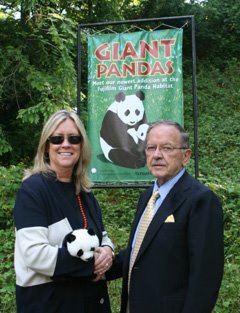
Alaska Republican senator Ted Stevens (above right), verbatim via WG Blog, Wired, & etc.:
"There's one company now you can sign up and you can get a movie delivered to your house daily by delivery service. Okay. And currently it comes to your house, it gets put in the mail box when you get home and you change your order but you pay for that, right.
But this service isn't going to go through the interent and what you do is you just go to a place on the internet and you order your movie and guess what you can order ten of them delivered to you and the delivery charge is free.
Ten of them streaming across that internet and what happens to your own personal internet?
I just the other day got, an internet was sent by my staff at 10 o'clock in the morning on Friday and I just got it yesterday. Why?
Because it got tangled up with all these things going on the internet commercially.
So you want to talk about the consumer? Let's talk about you and me. We use this internet to communicate and we aren't using it for commercial purposes.
We aren't earning anything by going on that internet. Now I'm not saying you have to or you want to discriminate against those people [...]
The regulatory approach is wrong. Your approach is regulatory in the sense that it says 'No one can charge anyone for massively invading this world of the internet.' No, I'm not finished. I want people to understand my position, I'm not going to take a lot of time. [?]
They want to deliver vast amounts of information over the internet. And again, the internet is not something you just dump something on. It's not a truck.
It's a series of tubes...."
Little Known Facts About Senator Stevens (via Wikipedia):
"When he is discussing issues that are especially important to him (such as opening up the Arctic National Wildlife Refuge to oil drilling), he wears a necktie with The Incredible Hulk on it to show his seriousness. Marvel Comics responded by sending him free Hulk paraphernalia and throwing a Hulk party for the Senator.
Stevens is the focus of the Ted Stevens Foundation, a charity established to 'assist in educating and informing the public about the career of Senator Ted Stevens.' Tim McKeever, who is chairman of the Foundation and is a lobbyist who was treasurer of Stevens’s 2004 campaign, has said that the charity is 'nonpartisan and nonpolitical.'"
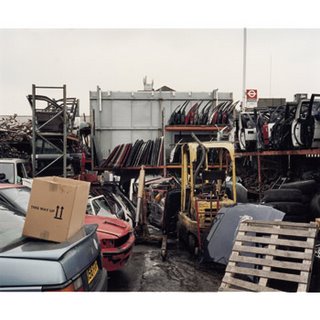
Untitled billboard photograph by UK artist Stephen Gill. Link courtesy Roy Arden. Gill's practice intrigues me: pictures, mostly (the audio recordings, etc. punctuating them seem like notably lesser works, a distraction), marked by Gill's encounters with concepualism (definitely Huebler, definitely Ruscha), but always focused on their subjects, and not on the "conceptual methodology" generating them.
This serial spirit -- rampantly curious; egalitarian; largely made by wandering around - is something genuinely new in photography. Lots of recent projects seem animated by a similar impulse: SGB's Every Bus Stop in Surrey, B.C.; Adam Harrison's 365 Sketches; Jamie Tolagson's 100 Views; Robert Linsley's 100 Views of Mount Baker; my ghosts. These pictures are all encyclopedic descriptions of a particular culture or place, and they all cast as wide a net as possible, in the hope of snaring representations of things that haven't made it into more idea-driven picture-making. Gill's series "Invisible," and "Billboards" are my favorites of those profiled on his site, with"Lost" bringing up third place. Also note Gill's generous offers of free limited edition pictures; this too is an impulse derived from conceptualism. Gill might as well have stamped his free bank machine photographs COLLECTION PUBLIC FREEHOLD.
Iain Sinclair, from a review on Gill's site: "
Sunday, July 02, 2006
There There
In pitch dark
I go walking in your landscape...
A possible soundtrack for all those cluttered black and whites a few months back.
(Alternative live version here)
Archives
03/01/2004 - 04/01/2004
04/01/2004 - 05/01/2004
05/01/2004 - 06/01/2004
06/01/2004 - 07/01/2004
07/01/2004 - 08/01/2004
08/01/2004 - 09/01/2004
09/01/2004 - 10/01/2004
10/01/2004 - 11/01/2004
11/01/2004 - 12/01/2004
12/01/2004 - 01/01/2005
01/01/2005 - 02/01/2005
02/01/2005 - 03/01/2005
03/01/2005 - 04/01/2005
04/01/2005 - 05/01/2005
05/01/2005 - 06/01/2005
06/01/2005 - 07/01/2005
07/01/2005 - 08/01/2005
08/01/2005 - 09/01/2005
09/01/2005 - 10/01/2005
10/01/2005 - 11/01/2005
11/01/2005 - 12/01/2005
12/01/2005 - 01/01/2006
01/01/2006 - 02/01/2006
02/01/2006 - 03/01/2006
03/01/2006 - 04/01/2006
04/01/2006 - 05/01/2006
05/01/2006 - 06/01/2006
06/01/2006 - 07/01/2006
07/01/2006 - 08/01/2006
08/01/2006 - 09/01/2006
09/01/2006 - 10/01/2006
10/01/2006 - 11/01/2006
11/01/2006 - 12/01/2006
12/01/2006 - 01/01/2007
01/01/2007 - 02/01/2007
02/01/2007 - 03/01/2007
03/01/2007 - 04/01/2007
04/01/2007 - 05/01/2007
05/01/2007 - 06/01/2007
06/01/2007 - 07/01/2007
07/01/2007 - 08/01/2007
08/01/2007 - 09/01/2007
09/01/2007 - 10/01/2007
10/01/2007 - 11/01/2007
11/01/2007 - 12/01/2007
12/01/2007 - 01/01/2008
01/01/2008 - 02/01/2008
02/01/2008 - 03/01/2008
03/01/2008 - 04/01/2008
04/01/2008 - 05/01/2008
05/01/2008 - 06/01/2008
06/01/2008 - 07/01/2008
07/01/2008 - 08/01/2008
08/01/2008 - 09/01/2008
09/01/2008 - 10/01/2008
10/01/2008 - 11/01/2008
11/01/2008 - 12/01/2008
12/01/2008 - 01/01/2009
01/01/2009 - 02/01/2009
02/01/2009 - 03/01/2009
03/01/2009 - 04/01/2009
04/01/2009 - 05/01/2009
05/01/2009 - 06/01/2009
06/01/2009 - 07/01/2009
07/01/2009 - 08/01/2009
08/01/2009 - 09/01/2009
09/01/2009 - 10/01/2009
10/01/2009 - 11/01/2009
11/01/2009 - 12/01/2009
12/01/2009 - 01/01/2010
01/01/2010 - 02/01/2010
02/01/2010 - 03/01/2010
03/01/2010 - 04/01/2010
04/01/2010 - 05/01/2010
05/01/2010 - 06/01/2010
06/01/2010 - 07/01/2010
07/01/2010 - 08/01/2010
08/01/2010 - 09/01/2010
09/01/2010 - 10/01/2010
10/01/2010 - 11/01/2010
11/01/2010 - 12/01/2010
12/01/2010 - 01/01/2011
01/01/2011 - 02/01/2011
02/01/2011 - 03/01/2011
03/01/2011 - 04/01/2011
04/01/2011 - 05/01/2011
05/01/2011 - 06/01/2011
06/01/2011 - 07/01/2011
07/01/2011 - 08/01/2011
08/01/2011 - 09/01/2011
09/01/2011 - 10/01/2011
10/01/2011 - 11/01/2011
11/01/2011 - 12/01/2011
12/01/2011 - 01/01/2012
01/01/2012 - 02/01/2012
02/01/2012 - 03/01/2012
03/01/2012 - 04/01/2012
04/01/2012 - 05/01/2012
05/01/2012 - 06/01/2012
06/01/2012 - 07/01/2012
07/01/2012 - 08/01/2012
08/01/2012 - 09/01/2012
09/01/2012 - 10/01/2012
10/01/2012 - 11/01/2012
11/01/2012 - 12/01/2012
12/01/2012 - 01/01/2013
01/01/2013 - 02/01/2013
02/01/2013 - 03/01/2013
03/01/2013 - 04/01/2013
04/01/2013 - 05/01/2013
05/01/2013 - 06/01/2013
06/01/2013 - 07/01/2013
07/01/2013 - 08/01/2013
08/01/2013 - 09/01/2013
09/01/2013 - 10/01/2013
10/01/2013 - 11/01/2013
11/01/2013 - 12/01/2013
12/01/2013 - 01/01/2014
01/01/2014 - 02/01/2014
02/01/2014 - 03/01/2014
03/01/2014 - 04/01/2014
04/01/2014 - 05/01/2014
05/01/2014 - 06/01/2014
06/01/2014 - 07/01/2014
07/01/2014 - 08/01/2014
08/01/2014 - 09/01/2014
09/01/2014 - 10/01/2014
10/01/2014 - 11/01/2014
11/01/2014 - 12/01/2014
12/01/2014 - 01/01/2015
01/01/2015 - 02/01/2015
02/01/2015 - 03/01/2015
03/01/2015 - 04/01/2015
04/01/2015 - 05/01/2015
05/01/2015 - 06/01/2015
06/01/2015 - 07/01/2015
07/01/2015 - 08/01/2015
08/01/2015 - 09/01/2015
09/01/2015 - 10/01/2015
10/01/2015 - 11/01/2015
11/01/2015 - 12/01/2015
12/01/2015 - 01/01/2016
01/01/2016 - 02/01/2016
02/01/2016 - 03/01/2016
03/01/2016 - 04/01/2016
04/01/2016 - 05/01/2016
05/01/2016 - 06/01/2016
06/01/2016 - 07/01/2016
07/01/2016 - 08/01/2016
08/01/2016 - 09/01/2016
09/01/2016 - 10/01/2016
10/01/2016 - 11/01/2016
11/01/2016 - 12/01/2016
12/01/2016 - 01/01/2017
01/01/2017 - 02/01/2017
02/01/2017 - 03/01/2017
03/01/2017 - 04/01/2017
04/01/2017 - 05/01/2017
05/01/2017 - 06/01/2017
06/01/2017 - 07/01/2017
07/01/2017 - 08/01/2017
08/01/2017 - 09/01/2017
09/01/2017 - 10/01/2017
10/01/2017 - 11/01/2017
11/01/2017 - 12/01/2017
12/01/2017 - 01/01/2018
01/01/2018 - 02/01/2018
02/01/2018 - 03/01/2018
03/01/2018 - 04/01/2018
04/01/2018 - 05/01/2018
05/01/2018 - 06/01/2018
06/01/2018 - 07/01/2018
07/01/2018 - 08/01/2018
08/01/2018 - 09/01/2018
09/01/2018 - 10/01/2018
10/01/2018 - 11/01/2018
11/01/2018 - 12/01/2018
12/01/2018 - 01/01/2019
01/01/2019 - 02/01/2019
02/01/2019 - 03/01/2019
03/01/2019 - 04/01/2019
04/01/2019 - 05/01/2019
05/01/2019 - 06/01/2019
06/01/2019 - 07/01/2019
07/01/2019 - 08/01/2019
08/01/2019 - 09/01/2019
09/01/2019 - 10/01/2019
10/01/2019 - 11/01/2019
11/01/2019 - 12/01/2019
12/01/2019 - 01/01/2020
01/01/2020 - 02/01/2020
02/01/2020 - 03/01/2020
03/01/2020 - 04/01/2020
04/01/2020 - 05/01/2020
05/01/2020 - 06/01/2020
06/01/2020 - 07/01/2020
07/01/2020 - 08/01/2020
08/01/2020 - 09/01/2020
09/01/2020 - 10/01/2020
10/01/2020 - 11/01/2020
11/01/2020 - 12/01/2020
12/01/2020 - 01/01/2021
01/01/2021 - 02/01/2021
02/01/2021 - 03/01/2021
03/01/2021 - 04/01/2021
04/01/2021 - 05/01/2021
05/01/2021 - 06/01/2021
06/01/2021 - 07/01/2021
07/01/2021 - 08/01/2021
08/01/2021 - 09/01/2021
09/01/2021 - 10/01/2021
10/01/2021 - 11/01/2021
11/01/2021 - 12/01/2021
12/01/2021 - 01/01/2022
01/01/2022 - 02/01/2022
02/01/2022 - 03/01/2022
05/01/2022 - 06/01/2022
06/01/2022 - 07/01/2022
12/01/2022 - 01/01/2023
01/01/2023 - 02/01/2023
03/01/2023 - 04/01/2023
05/01/2023 - 06/01/2023
08/01/2023 - 09/01/2023
11/01/2023 - 12/01/2023
04/01/2024 - 05/01/2024
05/01/2024 - 06/01/2024
03/01/2004 - 04/01/2004
04/01/2004 - 05/01/2004
05/01/2004 - 06/01/2004
06/01/2004 - 07/01/2004
07/01/2004 - 08/01/2004
08/01/2004 - 09/01/2004
09/01/2004 - 10/01/2004
10/01/2004 - 11/01/2004
11/01/2004 - 12/01/2004
12/01/2004 - 01/01/2005
01/01/2005 - 02/01/2005
02/01/2005 - 03/01/2005
03/01/2005 - 04/01/2005
04/01/2005 - 05/01/2005
05/01/2005 - 06/01/2005
06/01/2005 - 07/01/2005
07/01/2005 - 08/01/2005
08/01/2005 - 09/01/2005
09/01/2005 - 10/01/2005
10/01/2005 - 11/01/2005
11/01/2005 - 12/01/2005
12/01/2005 - 01/01/2006
01/01/2006 - 02/01/2006
02/01/2006 - 03/01/2006
03/01/2006 - 04/01/2006
04/01/2006 - 05/01/2006
05/01/2006 - 06/01/2006
06/01/2006 - 07/01/2006
07/01/2006 - 08/01/2006
08/01/2006 - 09/01/2006
09/01/2006 - 10/01/2006
10/01/2006 - 11/01/2006
11/01/2006 - 12/01/2006
12/01/2006 - 01/01/2007
01/01/2007 - 02/01/2007
02/01/2007 - 03/01/2007
03/01/2007 - 04/01/2007
04/01/2007 - 05/01/2007
05/01/2007 - 06/01/2007
06/01/2007 - 07/01/2007
07/01/2007 - 08/01/2007
08/01/2007 - 09/01/2007
09/01/2007 - 10/01/2007
10/01/2007 - 11/01/2007
11/01/2007 - 12/01/2007
12/01/2007 - 01/01/2008
01/01/2008 - 02/01/2008
02/01/2008 - 03/01/2008
03/01/2008 - 04/01/2008
04/01/2008 - 05/01/2008
05/01/2008 - 06/01/2008
06/01/2008 - 07/01/2008
07/01/2008 - 08/01/2008
08/01/2008 - 09/01/2008
09/01/2008 - 10/01/2008
10/01/2008 - 11/01/2008
11/01/2008 - 12/01/2008
12/01/2008 - 01/01/2009
01/01/2009 - 02/01/2009
02/01/2009 - 03/01/2009
03/01/2009 - 04/01/2009
04/01/2009 - 05/01/2009
05/01/2009 - 06/01/2009
06/01/2009 - 07/01/2009
07/01/2009 - 08/01/2009
08/01/2009 - 09/01/2009
09/01/2009 - 10/01/2009
10/01/2009 - 11/01/2009
11/01/2009 - 12/01/2009
12/01/2009 - 01/01/2010
01/01/2010 - 02/01/2010
02/01/2010 - 03/01/2010
03/01/2010 - 04/01/2010
04/01/2010 - 05/01/2010
05/01/2010 - 06/01/2010
06/01/2010 - 07/01/2010
07/01/2010 - 08/01/2010
08/01/2010 - 09/01/2010
09/01/2010 - 10/01/2010
10/01/2010 - 11/01/2010
11/01/2010 - 12/01/2010
12/01/2010 - 01/01/2011
01/01/2011 - 02/01/2011
02/01/2011 - 03/01/2011
03/01/2011 - 04/01/2011
04/01/2011 - 05/01/2011
05/01/2011 - 06/01/2011
06/01/2011 - 07/01/2011
07/01/2011 - 08/01/2011
08/01/2011 - 09/01/2011
09/01/2011 - 10/01/2011
10/01/2011 - 11/01/2011
11/01/2011 - 12/01/2011
12/01/2011 - 01/01/2012
01/01/2012 - 02/01/2012
02/01/2012 - 03/01/2012
03/01/2012 - 04/01/2012
04/01/2012 - 05/01/2012
05/01/2012 - 06/01/2012
06/01/2012 - 07/01/2012
07/01/2012 - 08/01/2012
08/01/2012 - 09/01/2012
09/01/2012 - 10/01/2012
10/01/2012 - 11/01/2012
11/01/2012 - 12/01/2012
12/01/2012 - 01/01/2013
01/01/2013 - 02/01/2013
02/01/2013 - 03/01/2013
03/01/2013 - 04/01/2013
04/01/2013 - 05/01/2013
05/01/2013 - 06/01/2013
06/01/2013 - 07/01/2013
07/01/2013 - 08/01/2013
08/01/2013 - 09/01/2013
09/01/2013 - 10/01/2013
10/01/2013 - 11/01/2013
11/01/2013 - 12/01/2013
12/01/2013 - 01/01/2014
01/01/2014 - 02/01/2014
02/01/2014 - 03/01/2014
03/01/2014 - 04/01/2014
04/01/2014 - 05/01/2014
05/01/2014 - 06/01/2014
06/01/2014 - 07/01/2014
07/01/2014 - 08/01/2014
08/01/2014 - 09/01/2014
09/01/2014 - 10/01/2014
10/01/2014 - 11/01/2014
11/01/2014 - 12/01/2014
12/01/2014 - 01/01/2015
01/01/2015 - 02/01/2015
02/01/2015 - 03/01/2015
03/01/2015 - 04/01/2015
04/01/2015 - 05/01/2015
05/01/2015 - 06/01/2015
06/01/2015 - 07/01/2015
07/01/2015 - 08/01/2015
08/01/2015 - 09/01/2015
09/01/2015 - 10/01/2015
10/01/2015 - 11/01/2015
11/01/2015 - 12/01/2015
12/01/2015 - 01/01/2016
01/01/2016 - 02/01/2016
02/01/2016 - 03/01/2016
03/01/2016 - 04/01/2016
04/01/2016 - 05/01/2016
05/01/2016 - 06/01/2016
06/01/2016 - 07/01/2016
07/01/2016 - 08/01/2016
08/01/2016 - 09/01/2016
09/01/2016 - 10/01/2016
10/01/2016 - 11/01/2016
11/01/2016 - 12/01/2016
12/01/2016 - 01/01/2017
01/01/2017 - 02/01/2017
02/01/2017 - 03/01/2017
03/01/2017 - 04/01/2017
04/01/2017 - 05/01/2017
05/01/2017 - 06/01/2017
06/01/2017 - 07/01/2017
07/01/2017 - 08/01/2017
08/01/2017 - 09/01/2017
09/01/2017 - 10/01/2017
10/01/2017 - 11/01/2017
11/01/2017 - 12/01/2017
12/01/2017 - 01/01/2018
01/01/2018 - 02/01/2018
02/01/2018 - 03/01/2018
03/01/2018 - 04/01/2018
04/01/2018 - 05/01/2018
05/01/2018 - 06/01/2018
06/01/2018 - 07/01/2018
07/01/2018 - 08/01/2018
08/01/2018 - 09/01/2018
09/01/2018 - 10/01/2018
10/01/2018 - 11/01/2018
11/01/2018 - 12/01/2018
12/01/2018 - 01/01/2019
01/01/2019 - 02/01/2019
02/01/2019 - 03/01/2019
03/01/2019 - 04/01/2019
04/01/2019 - 05/01/2019
05/01/2019 - 06/01/2019
06/01/2019 - 07/01/2019
07/01/2019 - 08/01/2019
08/01/2019 - 09/01/2019
09/01/2019 - 10/01/2019
10/01/2019 - 11/01/2019
11/01/2019 - 12/01/2019
12/01/2019 - 01/01/2020
01/01/2020 - 02/01/2020
02/01/2020 - 03/01/2020
03/01/2020 - 04/01/2020
04/01/2020 - 05/01/2020
05/01/2020 - 06/01/2020
06/01/2020 - 07/01/2020
07/01/2020 - 08/01/2020
08/01/2020 - 09/01/2020
09/01/2020 - 10/01/2020
10/01/2020 - 11/01/2020
11/01/2020 - 12/01/2020
12/01/2020 - 01/01/2021
01/01/2021 - 02/01/2021
02/01/2021 - 03/01/2021
03/01/2021 - 04/01/2021
04/01/2021 - 05/01/2021
05/01/2021 - 06/01/2021
06/01/2021 - 07/01/2021
07/01/2021 - 08/01/2021
08/01/2021 - 09/01/2021
09/01/2021 - 10/01/2021
10/01/2021 - 11/01/2021
11/01/2021 - 12/01/2021
12/01/2021 - 01/01/2022
01/01/2022 - 02/01/2022
02/01/2022 - 03/01/2022
05/01/2022 - 06/01/2022
06/01/2022 - 07/01/2022
12/01/2022 - 01/01/2023
01/01/2023 - 02/01/2023
03/01/2023 - 04/01/2023
05/01/2023 - 06/01/2023
08/01/2023 - 09/01/2023
11/01/2023 - 12/01/2023
04/01/2024 - 05/01/2024
05/01/2024 - 06/01/2024

